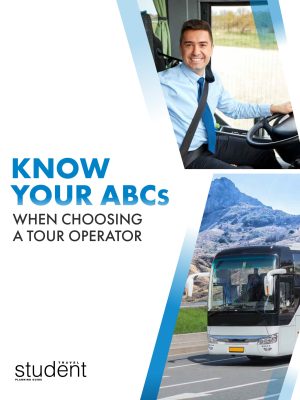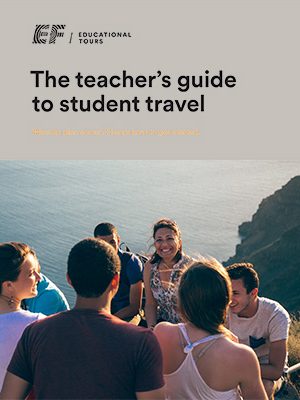We show you how to incorporate learning potential into any exciting class excursion to create fun, educational field trips
Field trips are a school year highlight for students and teachers. They offer a welcome break from the classroom routine and provide hands-on experiences that can spark curiosity and foster a life-long love and appreciation for learning. However, educators are responsible for ensuring that field trips are not only fun but also contain educational opportunities.
In this article, we will explore how to easily integrate education and learning opportunities into fun field trips, focusing on two popular fun field trip destinations: amusement parks and zoos. Although these two destinations are the focus of this article, the strategies put forth can be modified and applied to any fun field trip!

Child on a swing ride at an amusement park
The Power of Experiential Learning on Field Trips
Experiential learning, or learning by doing and experiencing, is a powerful tool for educators. It allows students to engage with concepts learned in the classroom in real-world contexts and settings, making abstract ideas more memorable and concrete. Field trips provide the perfect setting for this type of learning, offering sensory-rich environments that can serve children with all different learning styles. Fun and educational field trips are a cornerstone to real-world learning for all ages and stages of education.
Amusement Parks Can Be More Than Just Thrills; They Can Be Educational Field Trips!
Amusement parks might seem like an unlikely place for educational opportunities, but they’re ripe with chances for children to learn and explore various subjects. Here are some ways to incorporate learning into a day of fun at an amusement park:
Physics in Motion
Roller coasters and other amusement park rides aren’t just fun; they’re great examples of physics in action. Before the field trip, introduce basic physics concepts like acceleration, potential and kinetic energy, and centripetal force. During the visit, educators could:
- Have students estimate the height of different roller coasters and calculate the potential energy at the very top.
- Use a smartphone app to measure the G-force experienced on the rides.
- Have students guess how different shaped loops might affect the rider’s experience and then discuss their experience after the ride.

Rollercoaster at an amusement park
Mathematics of Fun
Amusement parks offer many opportunities to practice real-world math skills. Educators might consider the following ways to bring math into the amusement park fun equation:
- Challenge students to calculate the average wait time for rides.
- Have them create and analyze graphs of ride popularity throughout the day.
- Have students calculate the number of rides they could take each hour and during their trip based on ride wait time, number of rides, and time spent on each ride.
- Encourage budgeting skills by giving students a set amount of “money” to spend on food and souvenirs.
Business and Economics
Amusement parks are complex businesses that can teach students many valuable lessons related to business and economics. Educators might consider engaging students in the following ways:
- Discuss supply and demand with students using examples of busy vs. quiet days or on-season vs. off-season patrons and revenue.
- Speak with the marketing team at the amusement park and explore marketing strategies used by the park.
- Introduce strategy by analyzing the park’s layout and discussing why certain attractions are placed where they are.
Creative Writing and Storytelling
The imaginative environments in many parks can spark creativity in many areas for students. Consider incorporating the following into your next amusement park field trip:
- If relevant, have students create backstories for characters they encounter at the amusement park.
- Encourage descriptive writing by asking students to write in a journal about their sensory experiences and feelings throughout the day.
- Challenge older students to craft a short story set in the park and then read it aloud to the other students back in the classroom.

Giraffe at the Jacksonville Zoo in Jacksonville, Florida
Zoos as Living Science Classrooms
Zoos are fun and naturally offer a wealth of educational opportunities across several subjects, especially science. Here are some suggestions to consider incorporating into your next zoo trip to make for fun and educational field trips:
Biology and Ecology
The most obvious subject to explore at a zoo is life science. Take advantage of the myriad animal species by considering the following:
- Create scavenger hunts that require students to identify different species, habitats, and adaptations.
- Discuss food chains and ecosystems with students using the animals as examples.
- Explore concepts of genetics and heredity by observing different animal families.
- Sit in on a show or educational talk by one of the zookeepers where children can ask experts questions about the animals.
Geography and Climate
Zoos often group animals by their native regions, offering an excellent opportunity for students to learn about the geography and climate in which the animals live and thrive. Consider incorporating the following on your next zoo field trip:
- Have students create maps showing where different animals come from or drawings depicting an animal’s ideal environment.
- Discuss how climate affects animal adaptations, migration patterns, food, and familial functioning.
- Have students compare and contrast different biomes represented in the zoo in a journal they can bring along.
Conservation and Environmental Science
Many zoos have a strong focus on conservation. This is an ideal setting to get students thinking about animal conservation, endangered species and more. Educators could:
- Talk about different kinds of endangered species and the reasons for their decline.
- Enlighten students on what conservation is, explore the zoo’s conservation efforts, and brainstorm ways students can contribute at home and in the classroom.
- Take what students learn about conservation and create a class project to help an animal on the endangered species list.
- Analyze, discuss and/or journal about the impact of climate change on different species around the planet.

Elephant Festival in Jaipur, India
Cultural Studies
Animals play significant roles in various cultures, and the zoo is an opportune place to learn about them. Lean on the experts at the zoo and consider the following on your next field trip:
- Research and discuss the cultural significance of certain animals in different societies. Some examples may include the elephant in India or the manta ray in Polynesian culture.
- Explore how human-animal relationships vary across cultures and discuss the students’ relationships with animals (pets, wildlife around their home or school, farm life).
- Discuss ethical considerations surrounding zoos and animals in captivity.
Art and Observation
Zoos provide excellent opportunities for artistic expression and learning. To add a learning component that’s also fun to your zoo trip, try the following:
- Encourage students to sketch their favorite animals, focusing on specific features, behaviors or environments.
- Have students create “field guides” with detailed observations and drawings as if they were out on safari or trekking through the jungle researching wildlife.
- For older students, discuss how artists and scientists have depicted animals and used them as muses throughout history.
These strategies can also be adapted to other animal-centric field trip destinations, such as aquariums, farms, wildlife preserves, animal rescues and more.
Educational Field Trip General Strategies, While Still Planning for Fun
Regardless of the destination, there are some strategies that can help teachers maximize the educational value of any field trip:
Pre-Trip Preparation
- Introduce relevant concepts and topics to students in the classroom before the trip so they can be prepared once the day arrives.
- Have students write down and submit questions they would like answered during the visit. Utilize experts during the field trip and have students answer some of the questions at the end based on what they learned during the field trip.
- Provide students with an overview of what to expect on the field trip, including any specific learning goals or post-trip projects based on what they learned.

Structured Exploration
- Group students together in themed teams (you could call them “exploration teams”), each with a specific focus (e.g., “The Physics Team” at an amusement park or “The Conservation Team” at the zoo or aquarium).
- Provide worksheets, journals, or digital tools for collecting data and making observations while on the field trip.
- Schedule short group check-ins throughout the day where students and teachers can discuss their findings.
Post-Trip Reflection
- Dedicate class time to discussing and reflecting on the student’s experiences to solidify the learning that occurred on the field trip.
- Have students create projects or presentations to showcase what they learned and observed on the trip.
- Encourage students to connect their experiences to ongoing class topics throughout the rest of the school year. One way this could be done is to have students keep a journal.
Leverage Technology
- Utilize smartphone apps for collecting data, taking photos for documentation, and even include augmented reality experiences.
- Encourage responsible social media use for older students to share learning experiences with friends, family, and fellow schoolmates.
- Create collaborative digital spaces for students to share findings and reflections, such as online portfolios for sharing photos with captions or videos of a slideshow presentation that represents their learning and observations.
Engage with Experts
- Utilize the experts by arranging talks or Q&A sessions with staff members at the venue.
- Encourage students to ask thoughtful questions of guides and educators.
- Organize a behind-the-scenes tour for students to provide deeper learning, engagement, and insights.
Fun field trips to places like amusement parks and zoos offer a unique opportunity to infuse learning with fun in ways that can have a lasting, positive impact on students. By approaching these field trips with both careful planning and creativity, educators can transform a day of “just fun and excitement” into a rich, multifaceted, hands-on learning experience. The key is to view these trips as places of entertainment and fun and as living laboratories where students can engage with real-world applications of classroom concepts and ask experts questions. By striking the right balance, educators can create field trips that students will remember for years to come.









